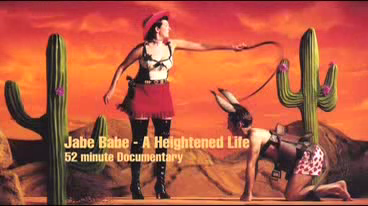Shaping the Real: Directorial imagination and the visualisation of evidence in the hybrid documentary
Janet Merewether
Introduction
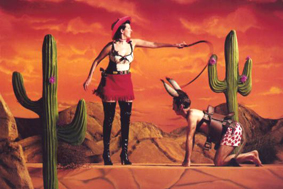
In this essay I propose a definition of the director’s role in documentary as creatively shaping reality, visualising and reframing evidence to form a representation of the figurative subject. I outline the ways in which I have developed a “ signature” hybridised filmmaking style exemplified by two recent documentaries, Maverick Mother (Merewether 2007), an autobiographical film about solo motherhood by choice and the contemporary role of the father, and Jabe Babe – A Heightened Life (Merewether 2005) which documents the life of Jabe Babe, a dominatrix living with the genetic condition Marfan Syndrome.
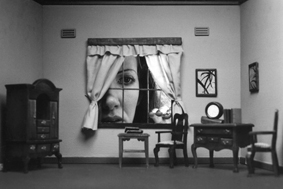
How is a documentary filmmaker’s distinct “signature” or “authorial voice” determined? Kochberg defines the auteur as a director who “stamps a personal – i.e. subjective – style on the work through repeated themes and/or visual style evident from film to film” (Kochberg 2002: 48). Somefilmmakers, such as Peter Greenaway (Act of God 1980), Mark Lewis (Cane Toads – An Unnatural History 1987) and Brian Hill (Drinking for England 1998) have developed recognisable structural, musical, visual and compositional strategies over long careers. Others such as Kim Longinotto (Divorce Iranian Style 1998) may be prominent due to their choice of radical, feminist or confronting subject matter. Filmmakers such as Agnès Varda (The Gleaners and I [Les Glaneurs et La Glaneuse] 2002) and Ross McElwee (Sherman’s March 1986) choose to present their idiosyncratic perspective on the world through the use of wry autobiographical monologue and a self-reflexive style which foregrounds the interactions between the director and the subject. Other directors such as Dennis O’Rourke (Cannibal Tours 1987) integrate their roles as director and cinematographer, making use of precise composition and selective framing, long takes and optical devices such as mirrors to establish meaning as well as their directorial presence. O’Rourke describes his films, such as Good Woman of Bangkok (O’Rourke 1991), as “Documentary Fictions”, as they self-consciously reveal themselves as constructed artefacts rather than “ the truth” :
Documentary Fiction is cinema which feels like life – and which is taken from real lives – but which, nevertheless, clearly asserts its own aesthetic – one which is recognisable as being related to the fiction film. The authenticity of the film – its “ truth” is entirely subjective.
(Berry, Hamilton & Jayamanne 1997: 212)
Austrian auteur Ulrich Seidl (Animal Love [Tiereische Liebe] 1995) is another contemporary documentary artist who produces confronting documentary fictions which blur the boundaries of social acting and directed performance, what Frey terms “border zones.” His style introduces a level of ambiguity to his fierce social critiques, challenging Direct Cinema purists wary of directorial interference. Seidl’s work is certainly not self-effacing; anyone who chooses the subject of the sensual and sexual relationship between owners and pets could expect to attract controversy. His stylistic rigour demonstrates what Kochberg describes as “truths mediated through…artistic obsessions.” (Kochberg 2002: 49)
As the above examples demonstrate, the authorship process in film documentary production can be as idiosyncratic as the director, and a personal methodology may take decades to develop. If, as in my own practice, the director is also the writer and producer, there is little doubt from whom the creative vision for the film originates, although the valuable contributions made by collaborators and crew members cannot be underestimated.
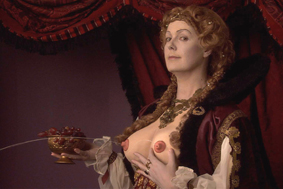
Through the production of numerous short films such as Palermo – ‘History’ Standing Still (2004), Cheap Blonde (1998), Contemporary Case Studies (2001) as well as the two documentary films under discussion, I have developed an authorial process founded in hybridity which integrates the disciplines of fiction, documentary, design and media art.
The scripts for both Jabe Babe – A Heightened Life and Maverick Mother integrate observational and fictional sequences to present the private world of the film subject whilst simultaneously contextualising them in the wider cultural, art/historical and media landscape. Observational filming captures the microcosm of individual and family life, whilst performative sequences reflexively situate this life within the macrocosm of society with its political, medical and religious institutions and moral codes. In this way I have blurred the boundaries of fact and fiction by inviting the key documentary participants to move beyond their participation as “social actors,” and into the role of performers enacting studio-based (frequently ironic) dramatised tableaux vivants.
My intention is to collapse the conventional distinction made between documentary and fiction, which had its origins in the early 1900s: “actualité” as established by the Lumière brothers’(L'arrivée d'un train en gare de La Ciotat [The Arrival of a Train at La Ciotat] 1895) was contrasted with Georges Méliès’ “fictive fantasy” spectacles such as Le Voyage dans la Lune [A Trip to the Moon] (Méliès 1902).In the hybrid documentary I demonstrate that directorial observation and imagination can be exercised in the representation of political, scientific and social subjects.
Whereas directors such as Seidl tend to conceal the level of directorial control and direction of performance during the filming process, I generally choose, in the manner of Jean Vigo in À propos de Nice (Vigo 1930) and Errol Morris in The Thin Blue Line (Morris 1988), to interweave a number of visually contrasting strands making the authorship process distinctly apparent to the audience. This methodology also acknowledges the influence of Jean Rouch, who, in films such as Moi, un Noir (Rouch 1959) demonstrates that documentaries can be likened to “dreams in film”, the result of an encounter between two people (Feld 2003), the director and subject.
The hybrid documentary
The postmodern hybriddocumentary is “authored ” in the sense that it self-consciously integrates several modes of production and is characterised by highly original directorial approaches which may become recognisable as the filmmaker’s “signature” style. I define the hybrid documentary as a non-fiction film which employs a stylised form of representation of the subjective voice and which may incorporate experimental and self-reflexive modes of production. The hybrid documentary frequently integrates fictional characteristics and formal innovation in performance, design and mise-en-scène.This mode of production often presents voices from the margins of society, and has been particularly embraced by feminist, queer and avant-garde filmmakers seeking to invert the position of the subject as victim and establish new aesthetic possibilities for the documentary. It may incorporate documentary, media art and performance art practice.
Hybrid documentary is also frequently eclectic, foregrounding its mode of construction, and revelling in the ironic celebration of quotation, artifice and fantasy, fused by self-conscious decoupage. It is reflective of the definition of hybridity in post-colonial and cultural studies as well as the biological sciences in that it seeks to artificially amalgamate disparate and incongruous cultures and sources into a unified whole. Post-colonial theorists have used the term to “question what appears natural and complete, to problematize naturalized boundaries.” (Kuortti & Nyman 2007: 1) In the biological sciences the term refers to “the notion of an organic process of the grafting of diversity into singularity” (Young 1995: 5) and of artificial cross-fertilisation.

The hybrid documentary might be characterised by its state of “in-betweenness” (Bhabha 1994: 10) in its integration of various genres and marginalised subjects just as the film-maker herself may be situated between the commercial film “industry” and art practice. Hybridity questions the existence of “objectivity” and fixed definitions of history, culture and identity. Its embrace of pastiche and fantasy differentiates it from the conventional definition of documentary as a conveyor of “truth,” or as Nichols proposes, a “history lesson…a discourse of sobriety…seldom receptive to whim or fantasy, to ‘make believe’ characters or imaginary worlds.” (Nichols 2001: 39). Kochberg suggests instead that “truths are subjective, multiple and at times contradictory.” (Kochberg 2002: 1) Hybrid documentaries eschew didactic stylistic features such as the “voice of God,” unless used ironically, preferring instead to foreground the expressive voice and perspective of the subject, who may also act as a performer.
Bruzzi posits a more contemporary definition of documentary “truth” as “that which emerges through the interaction between the filmmaker and the subject in front of the camera (classic direct cinema being predicated upon the different idea that documentary was simply the recording of events that would occur whether or not the cameras were present.)” (Bruzzi 2000: 76) New hybrid documentaries are frequently informed by the personal experience of the director, whose authorship process may be demonstrated through the use of self-presentation and/or first person narration. The indexical relationship to the “real” is contested territory even whilst a referential claim to the historical is retained. Th ough frequently based on real incidents or events, the hybrid film’s self-conscious use of stylisation exemplifies Sontag’s definition of “life as theatre,” (Sontag 1966) or, in Dovey’s words “documentary (as) performance.” (Dovey 2000: 10)
The authorship process – when to write and when to observe?
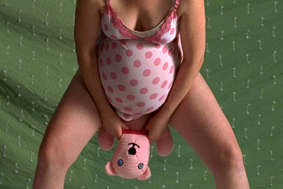
The hybrid documentaries Jabe Babe – A Heightened Life and Maverick Mother incorporate various modes including the “ observational” , “participatory” , “reflexive” and “performative”, as defined by Nichols (2001: 138). Social acting and choreographed performance sequences are integrated during the editing process. The films make use of the tableau vivant, both as an alienating device and as postmodern pastiche, which Kochberg defines as “an imitation of styles, without a sense of comic irony that you would associate with parody.” (Kochberg 2002: 202) Scripted studio sequences reinterpret an eclectic range of “low” and “high” cultural forms, quoting popular film and television imagery, such as 1950s B-grade and sketch comedy in Jabe Babe – A Heightened Life, and fine art photography artists Cindy Sherman and John Heartfield in Maverick Mother. The audience is able to observe the subjects of both films in the context of real life as well as in the film studio, enacting costumed personas. Detailed set, costume, make-up and wig design enable a clear distinction to be made between authentic and the reconstructed footage. T he “performative” scenes are used as humorous punctuation marks which diffuse dramatic tension whilst reinforcing the idea that our bodies and behaviours are frequently culturally determined: in real life we also play roles, whether it be “patient,” “mother,” or “woman.” The editing style is consciously fragmented and foregrounded, encouraging the audience to engage with the documentaries on multiple levels through emotional immersion and simultaneous intellectual analysis.
Although this previsualised material, founded in a form of scripting, implies stylistic control, frequently the strongest footage captured in the films I am discussing could never be imagined by a screenwriter. Who could predict that my elderly dying father, when presented with a photographic image of the father of my son, would respond with “He’s got the look of a canine.” (Maverick Mother ) As Varda’s films suggest, such as Les Glaneurs et la Glaneuse [The Gleaners and I], there is a distinct advantage in relinquishing control, for gleaning images spontaneously, capturing the unpredictability, authenticity and beauty of reality through the observational lens. I would argue that the combination of scripted and spontaneous components contributes to the conceptual and emotional strength of the hybrid documentary.
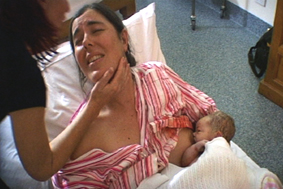
The writing process for the documentaries under discussion involves developing a script to distill the creative expression of the idea and the point of view: how I will visually and aurally interpret the subject. Unlike fiction, the script is rarely completed before filming commences, but is developed simultaneously with the research and observational shooting phases. I frequently include drawings, photomontage visualisations and reference images within the body of the script, which is formatted in the style of a feature film, with scene numbers, characters and dialogue. Although I operate the camera for the majority of the observational filming, a feature film crew is engaged for the studio shooting. This detailed script is required for creative crew collaboration and to allow analysis of film shoot logistics, such as planning for production, costume, makeup and model design, lighting, green screen and casting. The script structure, in particular the voice-over or central character’s narration, continues to be a work in progress until the film is locked off in the edit suite.
In Jabe Babe – A Heightened Life my authorial position is expressed through the use of a fragmented structure, quotation, creative use of production design, costumes, colour grading and film/video stocks as well as jump cuts and discontinuity in the editing style. In Maverick Mother my subjective position is unambiguous, as the film is autobiographical and my presence evident in front of as well as behind the lens.
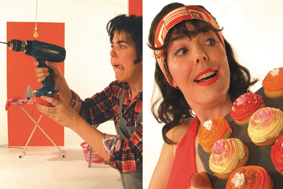
Nichols defines these new forms of documentary in terms of “incompleteness and uncertainty, recollection and impression, images of personal worlds and their subjective construction.” (Nichols 1993:174 ) I would also suggest that my personal style is defined through the choice of confronting, marginalised or contentious subject matter as well as a sense of the comedic, stemming from a feminist critique of established social conventions and power structures.
JABE BABE – A HEIGHTENED LIFE
Click image for video
The authored hybrid documentary frequently provides a space where under-represented groups such as women and queer subjects can articulate their own experiences in a stylised performative manner. Jabe, the subject of Jabe Babe – A Heightened Life, works as a dominatrix and has a life threatening genetic condition called Marfan Syndrome. Jabe’s early childhood experiences included living with her pyromaniac schizophrenic mother, before enforced removal and resettlement with a series of (frequently abusive) foster families. Health problems included myopia and heart complications as a result of her genetic condition, culminating in open-heart surgery at the age of sixteen. Jabe could be defined as a genetic, social and sexual outsider.
Bhabha suggests, in the context of post-colonial studies, that “ the intercultural space where hybrid identity is formed is a space of in-betweenness and liminality,” (Bhabha 1994, p. 8-9) a non-fixed identity. Jabe believes she is the product of a white mother and an aboriginal father; she has no fixed sense of belonging, family or home. Her physical appearance and sexuality is ambiguous and she is in a state of transition between life in the underworld profession of dominatrix to the socially acceptable nine to five worker. If hybridity can also be seen in the pejorative sense as a form of bastardisation, then Jabe’s unfixed identity, anti-authoritarian position and illicit profession constitutes the contemporary hybrid subject, the creative and irreverent protagonist.
Jabe Babe – A Heightened Life introduces the audience to Jabe’s character very differently from a standard science, medical or biographical documentary. The audience is encouraged to enter Jabe’s world of fantasy, “tall story” and intrigue from the film’s first scene, where a miniature book provides a whimsical introduction: “This story belongs to Jabe Babe who started small, but grew and grew…”. The documentary inverts the power relations normally found in the science documentary, where an “expert” doctor dominates and scrutinises the non-normative, objectified victim.
This subjective approach has a precedent in Kirby Dick’s documentary Sick: The Life & Death of Bob Flanagan, Supermasochist (Dick 1997). Suffering from cystic fibrosis, Flanagan is a performance artist basing his life and art on his body and his “SM” practice which expresses his obsession with ritualised torture. Flanagan lives with his dominatrix partner Sheree Rose and engages with pain in order to manage his fatal condition, which finally kills him. The structure of Sick is similar to Jabe Babe in that it interweaves the medical with the biographical and performative. The social subjects display a sense of agency and creative participation which challenge stereotypes of the medical patient as passive curiosity.
In Jabe Babe’s interview sequences, Jabe is a creative collaborator, addressing the viewer directly by speaking into the camera lens, making eye-contact and thus engaging the audience in her subjective experience. She is far from Anstey’s description of his social actors as “poor, suffering characters” in documentaries such as Housing Problems (Anstey 1935), as described by Winston (1988: 40) Jabe’s interview is set in a “technicolor treetop world” which reinforces Jabe’s height, isolation, and her world of escapism. In contrast, black and white interviews with medical experts appear on miniature monitors embedded in a model world, their power now diminished, controlled by Jabe as Giantess.
Marks writes that “Hybrid cinema is in a position…to dig up the traces that the dominant culture…would just as soon forget. One cannot simply contemplate a hybrid (or a work of hybrid cinema): one cannot help but be implicated in the power relations upon which it reflects.” (Marks 2000: 8) My intention with this film was to give power back to the subject by eschewing expository documentary conventions such as the detached “voice of god” in favour of Jabe’s active self-presentation through her idiosyncratic and distinctive voice. During the course of the documentary Jabe regains a sense of personal and economic control in her life, actively inverting her sense of embodiment from medical victim to professional dominatrix with a future plan to work in the funeral industry.
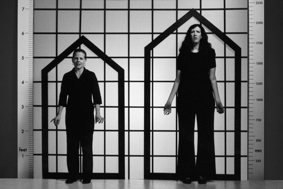
In the film Jabe participates in studio reconstructions of confronting black and white photographs contained in the medical journal “Birth Defects,” images of forlorn and frequently “deformed” patients: objects of medical scrutiny. These “objective” anthropometric measuring sequences are replicated ironically in the film in order to critique the unequal power relations she had experienced as a myopic and lanky Marfan child. Jabe describes her body as unstable and transgressive: “I was a freak… everything just grows and grows and grows!” Formal compositional devices and the positioning of the near naked subject, eyes blacked out, against a height grid, reference techniques used to capture photographic evidence in medical and criminal cases (Ehrlich & Jones 1967). Through the act of performative participation, Jabe is able to transcend her previous status as medical victim.
Jabe also participates as the performing subject in a series of vibrant tableaux vivants which represent storybook worlds, childhood memories, expectations of the future, as well as surreal colourful spaces of the imagination. These stylistically reference Méliès’ non-naturalistic “fictive fantasy” cinema spectacles such as Le Voyage dans la Lune [A Trip to the Moon] . The tableaux suggest the themes of acceptance, control, visual transformation, death and desire, enabling Jabe to enact different manifestations of her “female” self. Her love of theatrical exhibitionism and physical transformation form the central core of the film’s visual and performative strategies.
Butler elaborates on the concept of femininity itself as performance, suggesting that
“gender is a kind of persistent impersonation that passes as the real…Does being female constitute a “natural fact” or a cultural performance...?” (Butler 1990: x)
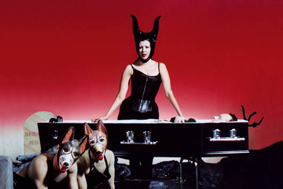
The tableaux also draw on burlesque imagery, such as the Klaws’ photographs of Bettie Page, “s/m b/d” subcultures, as well as storybook worlds such as Alice’s Adventures in Wonderland (Carroll 1865). Grosz writes of the morphing female subject, “Alice...is perpetually changing, not simply in terms of growth, development, or maturation, but in terms of orientations, directions, and trajectories”. (1994: 176) Jabe’s body, through childhood, was in a state of flux, and exhibited extraordinary growth and difference. In adulthood, her tall body, though female by sex, is open to other public interpretations, its appearance fluid, sometimes recognised as female, sometimes transsexual. Jabe plays with her androgyny, and her appearance is often unfixed and ambiguous. She contributed to the documentary authorship process by suggesting various self-devised characters such as Calamity Pain and the Queen of Mean.
I utilise the metaphor of the giantess to represent Jabe’s outsider status. She participates in visualisations of macrophilic fantasies, a term referring to the sexual fetish where men desire to be devoured, squashed or trodden on by giant, supersized women. In order to develop a visual style for the giantess sequences, I researched the production design, costume design and camera-work found in cult B-grade films such as Attack of the 50 Foot Woman (Juran 1958). Jabe often described herself as a contemporary “freak,” and the photographic work of Diane Arbus, the American photographer known for her images of social misfits and aberrant bodies provided compositional and framing concepts. By using recognisable popular iconography, the film explores the simultaneous desire for, and repulsion from, the dominating, sexually predatory female.
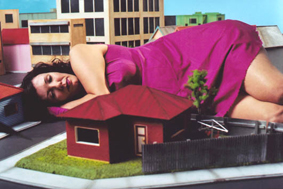
Jabe Babe – A Heightened Life’s concern with the image and the meta-image emerges through the construction and layering of frames within frames. Black and white observational scenes from Jabe’s real life play on miniature monitors nested within the “ technicolor” buildings in the model city. In a similar way, Pascoe writes that Peter Greenaway’s films, such as Les Morts de la Seine [Death in the Seine] (Greenaway 1988) make paradoxical demands on the audience, who must undertake “several acts of seeing simultaneously; following maps, say, or reading manuscripts, or looking at ornate calligraphy on screen while, at the same time, watching a film” (Pascoe 1997: 33) m arking “the beginning of the liberation of ‘ video’ from ‘ TV’ ”(Lewis 2006). In stylistic terms, Jabe Babe – A Heightened Life represents a liberation of the documentary from an indexical relationship to the “real”.
My next documentary Maverick Mother builds on the stylistic innovations I developed in Jabe Babe – A Heightened Life by exploring the idea of the participating author in the feminist autobiographical film. “At 39, Janet’s biological clock was chiming a deafening ‘ tic-toc’. A film about solo motherhood by choice and the contemporary role of the father.” (Maverick Mother Promotional Material)
MAVERICK MOTHER
Click image for video
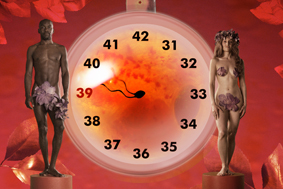
A Camera in the Kitchen
In 2004, having no idea of the final outcome, I commenced filming a video diary documenting my three year journey from single woman by chance to solo mother by choice. The filming began when, at the age of thirty-nine, I made the momentous decision to “go it alone” and look for a sperm donor.
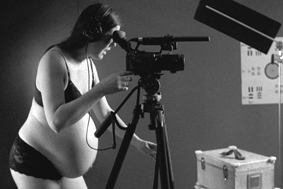
Maverick Mother builds upon some of the stylistic conventions found in the “autobiographical portrait” or “journal entry documentary” as defined by Lane (2002: 48), such as to-camera monologue by the filmmaker, as well as utilising hybrid techniques such as the integration of documentary, drama, archival and family imagery. My intention for this documentary was to use the autobiographical form to publicly examine the subject of the unmarried or unpartnered woman’s “biological clock” and desire for family, even though I knew that I would face considerable public scrutiny, a risk taken in any autobiographical endeavour. I was willing to sacrifice my personal privacy to encourage a public debate around the subjects of “social infertility”, the pain of childlessness, as well as men’s frequent unwillingness to maturely embrace their role as fathers in society. This documentary would be about “spinsters” doing it for themselves.
Observation, intervention and interaction with the family
The video diary, filmed over a three year period, documented my own experiences in the form of monologues as well as the responses of my friends and family.
After the birth of my son, Arlo, the documentary’s emphasis shifted, as I deeply considered the traditional and shifting contemporary role of the male “head of the household” through the incorporation of my father and brothers as key characters in the film. How would I raise Arlo without the presence of his biological father in our day to day lives? Through the use of interactive interviews I engage with my father’s traditional views on marriage, illegitimacy and the rights of my child to know his father and genetic origins. The diary became a record of the birth of my son, the ideological battles between Dad and me which served as dramatic tension in the film, then his declining health in hospital, which could be read as a metaphor for the demise of the patriarchal “head of the household.”
This diary footage forms the chronological spine to the film. The Colmers suggest (1987: 1) that “[a]s the art of confession, revelation and self-discovery, [the autobiography] has its roots in religion…Even today it retains a confessional strain.” The video camera frequently bears witness to my most intimate experiences of joy, anguish, confusion and constant questioning, enabling the audience to participate in my subjective experience and the challenges of my choice to “bypass the man and go straight for the sperm” (Maverick Mother). Self-reflexive devices, such as a mirror in the doctor’s surgery, allow the audience to simultaneously view the interview subject and the filmmaker-as-patient. In the feminist autobiography, it is the filmmaker’s capacity to control the representation of subjective embodiment and intimate experience through the authorship process that poses an alternative to conventional documentary practice.
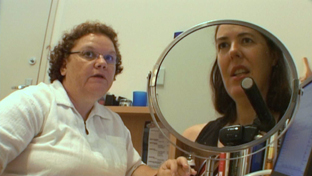
Background to women’s autobiographical documentary
Prevailing forms of the documentary before the 1960s reflected authoritarian tendencies towards the need for control, truth and objectivity. Zimmerman (1999: 64) describes this “imperialist gaze” in her discussion of Robert Flaherty as the “father of documentary”. She suggests that “[a]t documentary’s core dwells a patriarchal fantasy of origins, birthrights, territorialisation, disciplinary procedures of beautiful aesthetics to control unruly natives and racialized narratives...” (ibid). Holland and Adkins (1996: 1) note that “[R]adical feminists have long argued that the female body and sexuality are a site of control and potential contestation.” In Maverick Mother, the pregnant film author defies all “feminine” stereotypes by controlling the conditions of her pregnancy, birth and cinematic representation.
Feminist avant-garde and documentary directors have frequently used their embodied experience as a basis for creative expression. Juhasz (1999: 96) observes that
Women activists and artists are drawn to documentary and avant-garde form (and their hybridization)…[T]hese are documents of a politicised (usually autobiographical) self-expression: a woman performing and archiving her defiance against the rules of sex and gender.
Renov (1999: 88-89) also defines the historical development of feminist autobiography and its capacity to contribute to social change.
By 1990…subjectivity is no longer construed as ‘something shameful’; it is the filter through which the Real enters discourse as well as a kind of experiential compass guiding the work towards its goal as embodied knowledge…[S]ubjectivity, a grounding in the personal and the experiential, funnelled the engine of political action.
As I was challenging traditional social constructs of “the family” and “the father” it seemed reasonable to challenge the traditional conventions of “the documentary” as defined by predominantly male filmmakers of the post-war period. My film would be a subjective and intimate record of the specific corporeal and emotional experiences flowing through the maternal body. The camera becomes witness, companion (and “husband replacement” as my editor noted), recording abject maternal realities and the excess of bodily fluids including blood, milk, tears and baby excrement.
My practice follows in a tradition of film authors working with a process of autobiographical self-presentation such as Ross McElwee’s wry search for love in Sherman’s March (McElwee 1986), Sadie Benning’s pixelvision examination of bourgeoning lesbian identity in Girl Power (Benning 1992) and Caouette’s “living movie” Tarnation (Caouette 2003) where documentary subjects become “characters.” Stylistic similarities include autobiographical monologue, performative role-play and ironic emulation of mass media celebrities.
Maverick Mother visually references both lifecasting and vlog (video blog) techniques, which themselves borrow from precedents such as Warhol’s Sleep (Warhol 1963), however I would argue that my film could be described as authored rather than unmediated as it selects and edits in order to contexualise my personal experiences within the broader history of the rights and status of single mothers in society.
Participatory diary footage of my friends and family reveals a clear interaction between filmmaker and subject, and several self-reflexive sequences establish not only my filming process, but also the personalities of the central characters. At the start of the film my conservative yet eccentric father states “I mean, everybody’s very polite about you, and I think that they admire you…for a weirdo…who’s a filmmaker. I mean you can’t help being a weirdo when you’re a filmmaker.” When I later prepare to reveal the news of the pregnancy to my mother, the contentious nature of filmmaker intervention is explored. From behind the camera I speak to my brother Jim. “It’s going to be difficult to say anything.” He replies “It’s going to be difficult, and it’s going to be difficult with Mum having a camera in her face.” Upon learning of my pregnancy, my father speaks to me through the camera with bemusement. “How did I have a fallen woman for a daughter?” he asks, disguising his shame with humour. These sequences reveal the three-way relationship between subject, filmmaker and audience.
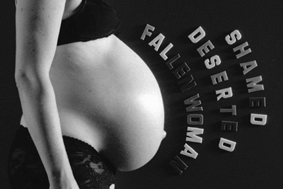
The performance of motherhood
Maverick Mother employs performance in order to contextualise my solo status historically whilst situating my conception and pregnancy within mass media and visual art representations of both the “revered mother” and the deviant “unwed mother.” Nichols (1993: 175) analyses the innovative documentary work of feminist filmmakers:
Some documentaries have begun to insist on the representation of experience and, therefore, the body itself as witness…[A filmmaker may resort] to classic devices of fictional mise-en-scèneto heighten the subjective sense of the interviewee’s body bearing witness… but it is a form of representation that breaks with documentary conventions of authenticity by resorting to a performance.
The introductory shot of the pregnant director behind the camera as well as the title sequence of the film, featuring faux lactating bare breasts references the work of photographer Cindy Sherman. They reflexively reveal my roles as cinematographer and director working in the context of the green-screen film studio. Even the absent father is represented through performance, as an enigmatic masked man with surfboard.
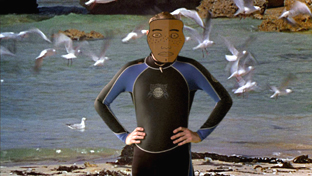
Reworking familiar maternal archetypes, the (frequently ironic) tableaux sequences in Maverick Mother reflect the extent of my conscious authoring and screenwriting process. Interwoven into the video diary footage, they serve as tools to shift the mood and pace of the film whilst engaging a broad audience in what would be normally considered a feminist subject. De Lauretis describes this as constructing a “feminist viewer position... regardless of the actual gender or subjectivity of the viewer.” (de Lauretis 1987)
Lesage (1999: 311) has also examined the aesthetic explorations of women’s autobiographical films.
Unlike social-issue documentarists working…in a realist mode, (many) women artists do not presume to represent a continuous stable identity or a cohesive self. Rather they pursue an epistemological investigation of what kinds of relations might constitute the self, using as a laboratory their own consciousness.
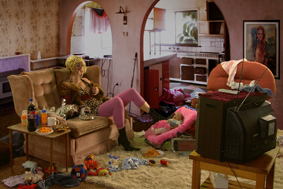
In Maverick Mother I perform as the “Pregnant Filmmaker”, “White Trash Single Mother”, “Shamed Pregnant Teenager”, “Single Mother as 1950s Housewife and Husband”, “Lactating Mother in WWI, WWII and the present” (against backgrounds of dead soldiers, atomic blasts and twin towers explosions) culminating in the “Madonna and Child.” As with the use of non-naturalistic performance in Jabe Babe – A Heightened Life, these representations serve to comment on the unstable, unfixed and culturally prescribed nature of the “female” in society. As Sontag writes, “Camp sees everything in quotation marks. It is not a lamp but a ‘lamp’; not a woman but a ‘woman.’ To perceive Camp in objects and persons is to understand Being-as-Playing-a-Role. It is the farthest extension, in sensibility, of the metaphor of life as theatre.” Sontag (1990: 280)
Other tableaux incorporate professional actors as performers, such as the pastiche of the horror film, a reference to Cronenberg’s The Brood (Cronenberg 1979), which serves as a shocking and blood-spattered prequel to the observational scene of my actual labour. Creed suggests in The Monstrous Feminine (1993: 43) that the horror genre negatively portrays women’s uncontrolled and threatening fecundity. In describing the “Women as Monstrous Womb” she writes that “the prototype of all definitions of the monstrous is the female reproductive body.” In Maverick Mother I do not shy away from the abject realities of motherhood – blood, shit, vomit and leakage from every orifice of both mother and baby are graphically captured in the video diary footage.
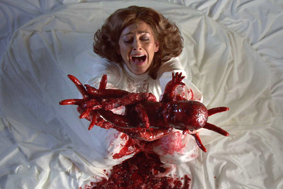
Nichols defines pastiche “as a postmodern tendency to recycle elements of past stories, styles, and histories in ways that drain them of affect” (Nichols 1994: 139), yet he admits that affective force can be gained through mixing this convention with traditional realism. Not all my dramatised sequences have ironic intent. One sequence representing a drowned (prop) baby accompanies shocking 19th century newspaper headlines reporting court proceedings brought against desperate unmarried mothers charged with infanticide. Another pastiche sequence of a blood spattered birth in a car transforms its tone from the ironic to affective as the voice-over describes a phone call from a friend who had just lost her baby due to a miscarriage.
Archival footage is also used in a self-conscious manner. An animated 1930s film of a tiny housewife mixing a cake, putting it into an oversized oven, then catching it as slides out through mid-air is interspersed throughout the film as a visual play on the expression “bun in the oven”, a euphemism for pregnancy. Due to the limitations of broadcast television and the censorship of the representation of the crowning of a baby’s head from the vagina during “prime time,” I inserted the flying bun footage ironically in what was otherwise an observational birth scene. This inclusion is a clear sign of authorial intervention in the documentary process and a comment on contemporary censorship restrictions.
Writing about innovative (auto)biographies, Waldman and Walker (1999: 269) note filmmaker Michelle Citron’s observations on the political aspects of the form:
An autobiographical work,” writes Citron, should be seen for the political act it is and not denigrated as a “trashy ‘true confession.’ ” “An autobiographical work,” she continues, “risks exposing that which the culture wants silenced.
Maverick Mother poses a challenge to the traditional concepts of family, fatherhood and the “good” or deserving mother. It exposes the silence around the subjects of the unmarried “spinster” and maternal longing. This documentary seeks to prompt questions rather than providing solutions, challenging the realist imperative for things to add up, conclude, culminate in a point. Trinh T. Minh-ha writes, in a statement which is particularly pertinent to Maverick Mother - a film about conception, pregnancy and birth - that “Seeking to perforate meaning by forcing my entry or breaking it open to dissipate what is thought to be its secrets seem to me as crippled an act as verifying the sex of an unborn child by ripping open the mother’s womb.” (Minh-ha 1989: 48-49)
Maverick Mother examines the social experiment of solo motherhood by choice and the redefinition of family structures through innovative use of performance and production design. While it employs a chronological narrative structure of conception, pregnancy and birth, it s subjective position does not seek to present “facts,” propose a conclusion or the definitive truth. The affective freeze frame at end of film, where the filmmaker holds her infant son Arlo up to the Super 8 camera lens, is a reference to Truffaut’s The 400 Blows [Les quatre cents coups] (Truffaut 1959). It is perhaps asking: what will be the next chapter in this boy’s life?
We may well ask, what will be the future of the subjective, authored documentary?
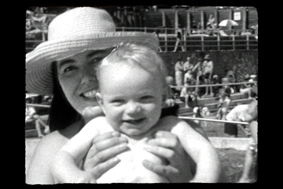
The future
Will the director-as-author continue to be financed to produce innovative hybrid documentaries for terrestrial or cable television in the coming decade? Is the proliferation of “documentary-lite” or “factual entertainment” reality formats as well as the amateur, unmediated vlog a threat to the structured, coherent argument, specialised research and sophisticated visual style employed by the professional director: the “dialectic of high versus low culture?” (Kochberg 2002: 49)
Werbner has noted that aesthetic or intentional hybridity serves to “shock, change, challenge, revitalise or disrupt through deliberate, intended fusions’ and in so doing ‘create an ironic double consciousness” (Werbner 1997: 5). Is there a danger that the simplistic process of “content-capture” will mean the loss of such approaches in documentary filmmaking, that it will replace a disciplined, conceptual and selective framing process and the production of thoughtful, complex documentary films? For DIY operators, the camera is simply “on” or “off,” the visual style established through the inherent qualities of the medium itself, rather than self-consciously crafted. Will the artlessness (intended or unintended) and immediacy characteristic of the mobile phone camera or computer webcam undermine the considerable artisanal skills employed by the documentary auteur? Or can we, as directors, view this democratisation of media not as a threat but as an opportunity to integrate multiple methods of high definition and lo-fi imaging technologies within single productions, as exemplified in Jabe Babe – A Heightened Life and Maverick Mother?
While terrestrial and cable television may continue to commission authored documentaries, it is likely that this form will also continue to proliferate as theatrical and VOD (Video On Demand) platforms generate niche and specialist markets. A disadvantage of the authored documentary is its relative expense in comparison with generic reality and factual entertainment formats and its rejection of the view of directors as “guns for hire.” There is a current trend for corporate producers and broadcasters to favour the “field producer” rather than the “writer/director” model. In this production scenario, the field producer is employed instead of a director, and is briefed by the producer to source, film and interview subjects, before being required to deliver the footage to an editor working for the production company. The exclusion of the director from the editorial process seriously jeopardises the trust established between the director and the filmed subject and the filmmaker’s ethical obligation to respectfully represent the social actor’s story.
It has been claimed that the web offers a “democratisation” of the media and a new opportunity for self-publishing and authorship. Certainly, a diverse range of voices and perspectives are now represented. H owever, it has also been suggested that the majority of individuals who upload videos to sites such as You Tube are white middle-class teenage males , suggesting that marginalised voices and perspectives are not necessarily being served by these new platforms. If a level of “expertise” has been rejected in the production of forms such as the video blog, what does this shift mean for the future of professional film education and training? For audiences, the level of authenticity and naivety is evidently appealing.
In a globalized media landscape diverse social, gender and political perspectives need to be valued, as they are frequently under threat. After all, women’s, queer and marginalised authorial voices emerged in the 1970s after having been locked out of professional training, financing and exhibition for most of the 20th century. Their subjective perspectives gradually emerged through community video and avant-garde circles before being accepted into the legitimate “film and television industry.”
The auteur voice is influential in its provision of ethically sound, diverse cultural, class, sexual, gender perspectives and stylistic treatments. Documentary forms continue to adapt and engage with increasingly participatory audiences. Authored hybrid documentaries, considered by some to be “high brow,” contribute innovation, irreverence and diversity to our media industry.
VIDEO / FILMOGRAPHY
Anstey, E. (1935) Housing Problems, UK: British Commercial Gas Association
Benning, S. (1992) GirlPower, USA
Caouette, J. (2003) Tarnation, USA: Nightlight Pictures
Cronenberg, D. (1979) The Brood, Canada: Productions Mutuelles
Dick, K. (1997) Sick : The Life & Death of Bob Flanagan, Supermasochist, USA
Greenaway, P. (1980) Act of God: Some Lightning Experiences 1966-1980 , UK: Thames
Greenaway, P. (1989) Les Morts de la Seine [Death in the Seine], UK: Errato Films
Hill, B. (1998) Drinking for England, UK: Century Films
Juran, N. (1958) The Attack of the 50 Foot Woman, USA: Woolner Bros
Lewis, M. (1987) Cane Toads- An Unnatural History, Australia: Film Australia
Longinotto, K. (1998) Divorce Iranian Style, UK: Twentieth Century Vixen
Lumière A. & Lumière L. (1895) L'arrivée d'un train en gare de La Ciotat [The Arrival of a Train at La Ciotat], France: Association Frères Lumièr
McElwee, R. (1986) Sherman’s March, USA: McElwee Productions
Méliès, G. (1902) Le Voyage dans la Lune [A Trip to the Moon], France: Star Film
Merewether, J. (1998) Cheap Blonde, Australia: Go Girl Productions
Merewether, J. (2001) Contemporary Case Studies, Australia: Go Girl Productions
Merewether, J. (2004) Palermo – ‘History’ Standing Still, Australia: Go Girl Productions
Merewether, J. (2005) Jabe Babe – A Heightened Life, Australia: Go Girl Productions (gogirlproductions.com.au)
Merewether, J. (2007) Maverick Mother, Australia: Go Girl Productions (www.maverickmother.net)
Morris, E. (1988) The Thin Blue Line, USA: The Program Development Company in association with Channel 4
O’Rourke, D. (1987) Cannibal Tours, Australia: CameraWork
O’Rourke, D. (1991) The Good Woman of Bangkok, Australia: CameraWork
Paik, N. J. (1974) TV Garden, USA
Rouch, J. (1959) Moi, un Noir, France: Les Films de la Pléiade
Seidl, U. (1995) Tiereische Liebe [Animal Love], Austria: Lotus Film
Truffaut, F. (1959) Les quatre cents coups [The 400 Blows], France: Films du Carrosse
Varda, A. (2002) Les glaneurs et la glaneuse [The Gleaners and I], France: Ciné-Tamaris
Vigo, J. (1930) À Propos de Nice, France: Institut National de l'Audiovisuel
Warhol, A. (1963) Sleep, USA: Andy Warhol
SELECTED BIBLIOGRAPHY
Berry, C., Hamilton, A., Jayamanne, L. (eds) (1997) The Filmmaker and the Prostitute: Dennis O’Rourke’s The Good Woman of Bangkok, Sydney: Power Publications
Bhabha, H. (1994) The Location of Culture, London and New York: Routledge
Bruzzi, S. (2000) New Documentary: A Critical Introduction, London: Routledge
Butler, J. (1990) Gender Trouble: Feminism and the Subversion of Identity, London and New York: Routledge
Butler, J. (1993) Bodies that Matter: On the Discursive Limits Of Sex, London and New York: Routledge
Carroll, L. (1865, reprinted 1974), Alice’s Adventures in Wonderland, London:
Macmillan
Citron, M. (1999) “Fleeing from Documentary: Autobiographical Film/Video and the Ethics of Responsibility” in D. Waldman and J. Walker (eds) Feminism and Documentary, Visible Evidence, vol. 5, Minneapolis and London: University of Minnesota Press
Colmer, J. and D., (1987) The Penguin Book of Australian Autobiography, Ringwood: Penguin Books
Creed, B. (1993) The Monstrous-Feminine: Film, Feminism, Psychoanalysis, London and New York: Routledge
Dovey, J. (2000) Freakshow: First Person Media and Factual Television,London Sterling, Va: Pluto Press
Ehrlich, S., Jones, L. (1967) Photographic Evidence: The Preparation and Use of Photographs in Civil and Criminal Cases, London: MacLaren
Feld, S. (ed.) (2003) Ciné-Ethnography-Jean Rouch, Visible Evidence, vol. 13, Minneapolis and London: University of Minnesota Press
Frey, M. (2004) “Border Zones: The Films of Ulrich Seidl”, Senses of Cinema, Melbourne, http://www.sensesofcinema.com/contents/04/32/ulrich_seidl.html accessed June 2007 Holland, J., Adkins, L. (eds) (1996) Sex, Sensibility and the Gendered Body, London: MacMillan
Juhasz, A. (1999) “Bad Girls Come and Go, But a Lying Girl Can Never Be Fenced In” in D. Waldman and J. Walker (eds) Feminism and Documentary, Visible Evidence, vol. 5, Minneapolis and London: University of Minnesota Press
Kochberg, Searle (ed.) (2002) Introduction to Documentary Production: a guide for media students, London and New York: Wallflower Press
Kuortti, J. Nyman, J. (eds) (2007) Reconstructing Hybridity – Post-Colonial Studies in Transition, Amsterdam and New York: Rodopi
Lane, J. (2002) The Autobiographical Documentary in America, Madison: University of Wisconsin Press
de Lauretis, T. (1987) “Rethinking Women’s Cinema” in Technologies of Gender, Bloomington: Indiana University Press
Lesage, J. (1999) “Women’s Fragmented Consciousness in Feminist Experimental Autobiographical Video” in D. Waldman, J. Walker (eds), Feminism and Documentary, Visible Evidence, vol. 5, Minneapolis and London: University of Minnesota Press
Lewis, J. (2006) “Nam June Paik: The man who invented video art”, Slate, http://www.slate.com/id/2135349/, accessed July 2007
Marks, L. (2000) The Skin of the Film: Intercultural Cinema, Embodiment, and the Senses, Durham and London: Duke University Press
Mazierska, E., Rascaroli, L. (2004) The Cinema of Nanni Moretti: dreams and diaries, London and New York: Wallflower Press
Nichols, B. (1993) “‘Getting to Know You…’: Knowledge, Power, and the Body” in M. Renov (ed.) Theorizing Documentary, London and New York: London and New York
Nichols, B. (1994) Blurred Boundaries: Questions of Meaning in Contemporary Culture, Bloomington and Indianapolis: Indiana University Press
Nichols, B. (2001) Introduction to Documentary, Bloomington and Indianapolis: Indiana University Press
Pascoe, D. (1997) Peter Greenaway – Museums and Moving Images, London: Reaktion Books
Renov, M. (1999) “New Subjectivities: Documentary and Self-Representation in the Post-Verité Age” in D. Waldman and J. Walker (eds) Feminism and Documentary, Visible Evidence, vol. 5, Minneapolis, London: University of Minnesota Press
Rotha P. (1952 orig. 1935) The Documentary Film (2nd Edition), London: Faber
Sontag, S. (1990,1966) “Notes on Camp” in S. Sontag (ed.) Against Interpretation and Other Essays, New York: Anchor Books
Trinh T. Minh-ha (1993) “The Totalizing Quest of Meaning” in M. Renov (ed.) Theorizing Documentary, London and New York: Routledge
Trinh T. Minh-ha (1989) Women, Native, Other: Writing on Post-Coloniality and Feminism, Bloomington and Indianapolis: Indiana University Press
Waldman, D., Walker, J. (eds) (1999) Feminism and Documentary, Visible Evidence, vol. 5, Minneapolis and London: University of Minnesota Press
Werbner, P., Modood, T. (eds) (1997) Debating Cultural Hybridity, London and New Jersey: Zed Books
Winston, B. (1988) “The Tradition of the Victim in the Griersonian Documentary” in A. Rosenthal (ed.) New Challenges for Documentary, Berkeley and Los Angeles: University of California Press
Young, R. (1995) Colonial Desire: Hybridity in Theory, Culture and Race, London:Routledge
Zimmermann, P. R. (1999) “Flaherty’s Midwives” in D. Waldman, J. Walker (eds) Feminism and Documentary, Visible Evidence, vol. 5, Minneapolis and London: University of Minnesota Press
